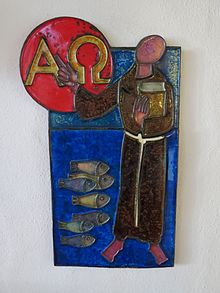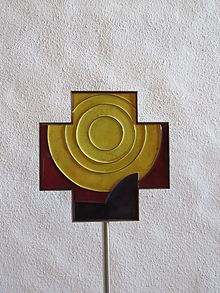St. Georg (Elgg)
The Church of St. Georg is the Roman Catholic parish church of Elgg in the Zurich district of Winterthur . The parish belonging to this is responsible for the places Elgg, Hagenbuch and Hofstetten .
history
History and naming
In the document that first mentions Elgg as "Ailaghoga" in 760, there is also the first mention of an Elgg church. This was later extended westward, replaced in the year 1000 by a high medieval church, which itself was rebuilt and expanded in 1370. In the years 1508–1518 a late Gothic church was built, which was used for Reformed church services after the Reformation in 1524. From then on, Catholic worship was banned in what is now the Canton of Zurich until the 19th century. The Edict of Tolerance of 1807 allowed a Catholic worship service in the canton of Zurich for the first time, but only in the city of Zurich. In 1813, 50 Catholics living in the city of Winterthur appealed to the city fathers to be tolerant . However, it was not until 1862, when the Rheinau monastery was abolished and the further use of its property was legally regulated by the canton of Zurich, that the first Catholic worship service since the Reformation was allowed to take place in Winterthur. The so-called First Zurich Church Law from 1863 recognized Zurich as well as the Catholic parishes in Winterthur, Rheinau and Dietikon (the last two were traditionally Catholic places), so that a Catholic parish could be established in Winterthur. In 1868 the newly built St. Peter and Paul Church was opened in the presence of representatives of the cantonal government, including state clerk and poet Gottfried Keller, and the city council of Winterthur. However, the establishment of further parishes in the canton was not recognized by the state, which is why these had to be set up on the basis of private and association law.
Development and construction history
In 1958 the pastor of Aadorf, a neighboring town in Thurgau, gave religious instruction in Elgg. In the following year the decision was made to build a Catholic church in Elgg. In 1961, a building site for the church was acquired at Winterthurerstrasse 5 in Elgg. On October 29, 1962, the Bishop of Chur , Johannes Vonderach , elevated to a pastoral care district together with Hagenbuch and Hofstetten after a tour of the Elgg building site. On December 10, 1962, the first service for the Elgg Catholics was held in the Klingenzell pilgrimage church . A week later, the first Catholic service since the Reformation took place in Elgg. The place of worship was the common room of the primary school building. On July 22nd, 1963, construction began on the first Catholic church in Elgg based on plans by the local architect P. Fleischmann. The church was consecrated on September 17, 1963. Even if this building was only an emergency church , its construction was convincing, which is why another church was built by P. Fleischmann in Feuerthalen three years later based on its model, which was used as a predecessor for today's St. Leonhard church until 2006 was. The emergency church in Elgg, on the other hand, was replaced by today's second Catholic church in Elgg after 18 years of use. However, since the first church still had a good building structure, it was dismantled in Elgg and given away to Bütschwil , where it was used as a youth center for several years. During the construction of the new church, a small emergency church was built on the building site. On October 4, 1981, the foundation stone was laid for the new church, which was built according to plans by the Elgger architects Luciano Valsecchi and Bretscher. On September 4, 1982, the completed church was consecrated by Bishop Johannes Vonderach.
The parish of Elgg with its 1,239 members (as of 2017) is one of the small Catholic parishes in the canton of Zurich.
Building description
Church tower and exterior
Located on Winterthurerstrasse , the St. Georg church is set back a little and can be reached via a forecourt. The concrete church is easted and has a pent roof , at the highest point of which the bell chamber is let into the building. On the northeast facade there is a relief by the Wiler sculptor Willi Buck. This relief depicts the patron saint of the church , St. George killing the dragon as a symbol of all evil. The church building is crowned by an iron cross. On June 12, 1982 the three bells were raised in the church tower.
| number | Weight | volume | dedication | inscription |
|---|---|---|---|---|
| 1 | 1120 kg | e 1 | Trinity | Grace to you and peace from God the Father, the Son and the Holy Spirit. |
| 2 | 650 kg | g 1 | Christ | Jesus Christ yesterday and today and the same also in eternity. |
| 3 | 480 kg | a 1 | Guardian Angel | I will send an angel to go ahead of you. Pay attention to him and hear his voice! |
Interior and artistic equipment
Through the entrance portal, the visitor arrives in a foyer , from which access to the premises of the parish center and the church is possible. The church, which was designed as a polygonal space, is located on the ground floor . The pews are grouped around the slightly raised chancel. The altar , ambo and the base of the tabernacle were designed by the architect Luciano Valsecchi. On the wall behind the altar is a mosaic that was designed by parishioners based on a design by the artist Christof Zünd, Guntershausen . He also created the following artistic works in the church: the lecture cross (near the baptismal font), the enamel pictures of St. George and St. Anthony , two further pictures in the meditation room , the shrine for St. Oele and an enamel picture in the foyer which the mosaic on the altar wall was designed. The church has two stained glass windows: The first shows the church patron, St. George. This glass window comes from the artist José de Nève, Oberdorf NW and was already in the previous building. The second glass window was redesigned for the new church. It deals with the history of Elgger and was designed by Willi Buck. The tabernacle and the cross in the chancel were also made by this artist.
organ
On the north wall of the church is the organ, which was built in 1983 by Orgelbau Späth , Rapperswil. The instrument has 15 registers. The game and stop action are mechanical. The intonation was done by Hubert Zemp and Konrad Bucher, the expertise was carried out by Ambros Koch from Fischingen Abbey . The inauguration of the organ took place on Sunday, February 26, 1984.
|
|
|
||||||||||||||||||||||||||||||||||||||||
- Coupling : II / I, I / P, II / P
- Playing aids : change kicks for mixture 2 ′ and prong 8 ′
literature
- Episcopal Ordinariate Chur (ed.): Schematism of the Diocese of Chur. Chur 1980.
Web links
Individual evidence
- ↑ Episcopal Ordinariate of the Diocese of Chur (ed.): Schematism of the Diocese Chur. P. 204.
- ^ Peter Niederhäuser and Flurina Pescatore: St. Peter and Paul. The mother church of Katholisch-Winterthur. Pp. 7-17.
- ^ Website of the parish of St. Georg Elgg, section history. Retrieved February 4, 2014.
- ↑ Catholic Church in the Canton of Zurich (Ed.): Annual Report 2017. P. 83.










